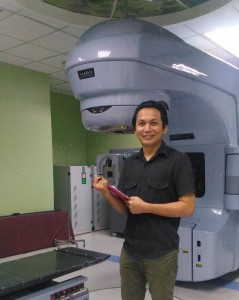We are pleased to congratulate Dr. Azrul Yahya for being awarded a PhD in Medical Physics from the School of Physics, University of Western Australia.
Azrul’s thesis title was: “Characterising and modelling the normal tissue effects associated with prostate cancer radiotherapy“.
Here are his principal supervisor-Prof. M. Ebert’s comments:
“Azrul came to UWA in 2012, and was open to undertaking a PhD in almost any area related to radiotherapy physics. We really needed someone to analyse the outcomes data we had obtained from a large clinical trial – this would involve a great deal of data processing and statistics, in an area that people had looked at before with minimal success.
Azrul took the project on with a great deal of enthusiasm and quickly demonstrated his capacity to undertake the type of work required. Azrul basically taught himself most of the statistical and advanced analytical methods required for the project, and ended up generating results that, at the start of his project, I had never envisaged. Azrul has progressed our understanding of the field he worked in, has established mechanisms by which we can reduce the side-effects of cancer therapy, and while doing so took the opportunity to present his work and learn from others in Europe, the United Kingdom, and Asia. It was a pleasure having Azrul in our team, and we all look forward to maintaining a strong bond with him wherever he is”.
And here are Azrul’s answers to our questions about his experience as a PhD candidate in our group:
Introduction and your current position and role:
I am Noorazrul. I just completed my PhD in Medical Physics under the supervision of Adj. Prof Martin Ebert and Assoc. Prof Mike House. I am currently an academic staff at The National University of Malaysia (UKM).
What did you enjoy most about UWA?
First of all, UWA was probably designed to embody the spirit of Perth; outdoorsy and laid-back. The Matilda Bay and Kings Park are just a short stroll from UWA. These make a good study environment. Second, I enjoyed the access to interesting talks in arts and social sciences, cultural events and music that students have access to.
Most importantly, UWA has well-connected academics which enable collaborative efforts with scientists across the globe. This is vital for research students like myself.
Can you give us your top three reasons to study Medical Physics?
1- Medical Physics is a rather highly interconnected field. Scientists including radiation oncologists, biologists and computer scientists alongside medical physicists usually work together for a common goal. This makes it interesting.
2- In the clinical setting, medical physics is rarely a one-man-show profession. We have radiologists, radiation oncologists, radiation technologists and nurses as part of the team. Again, this makes it interesting.
3- It just feels good to be a part of the team to treat and to improve the quality of life of cancer patients.
How do you feel you have made a difference in your field of research?
I have just completed my studies less than 3 months ago. So, I guess I have yet to make a substantial difference to the field. During my studies, however, we managed to publish several papers on the prediction of urinary symptoms following prostate radiotherapy. The reports try to look at associations of technical, clinical and dose factors to urinary symptoms. We also tried to look at improving the predictive models through the use of a more robust modelling strategy, improvisation of model development and reporting and through the development of novel dose measures.
It is in my plan to pursue studies related to the use of genetic information as predictors of heightened radiosensitivity for certain patients.
What is your best advice to current students and Medical Physics applicants?
UWA provides many avenues to achieve excellence. Grab it.
And here is a list of Azrul’s publications during his PhD at UWA:
Yahya, N., Ebert, M.A., Bulsara, M., House, M.J., Kennedy, A., Joseph, D.J., Denham, J.W. 2016, ‘Statistical-learning strategies generate only modestly performing predictive models for urinary symptoms following external beam radiotherapy of the prostate: A comparison of conventional and machine-learning methods’, Medical Physics, 43, 5, pp. 2040-2052.
Yahya, N., Ebert, M.A., Bulsara, M., Haworth, A., Kennedy, A., Joseph, D.J., Denham, J.W. 2015, ‘Dosimetry, clinical factors and medication intake influencing urinary symptoms after prostate radiotherapy: An analysis of data from the RADAR prostate radiotherapy trial’, Radiotherapy and Oncology, 116, 1, pp. 112-118.
Yahya, N., Ebert, M.A., Bulsara, M., House, M.J., Kennedy, A., Joseph, D.J., Denham, J.W. 2015, ‘Urinary symptoms following external beam radiotherapy of the prostate: Dose-symptom correlates with multiple-event and event-count models’, Radiotherapy and Oncology, 117, 2, pp. 277-282.
Yahya, N., Ebert, M.A., Bulsara, M.K., Haworth, A., Kearvell, R., Foo, K., Kennedy, A.M., Richardson, S.C., Krawiec, M., Joseph, D.J., Denham, J.W. 2014, ‘Impact of treatment planning and delivery factors on gastrointestinal toxicity: An analysis of data from the RADAR prostate radiotherapy trial’, RADIATION ONCOLOGY, 9, 1, pp. 1-10.
Yahya, N., Ebert, M.A., Bulsara, M.K., Kennedy, A.M., Josephc, DJ. Denham, J.W. 2016, ‘ Independent external validation of predictive models for urinary dysfunction following external beam radiotherapy of the prostate: Issues in model development and reporting’, Radiotherapy and Oncology, 120, 2, pp. 339–345.
Yahya, N., Ebert, M. A., House, M. J., Kennedy, A., Matthews, J., Joseph, D. J. & Denham, J. W. 2017, ‘Modeling Urinary Dysfunction After External Beam Radiation Therapy of the Prostate Using Bladder Dose-Surface Maps: Evidence of Spatially Variable Response of the Bladder Surface’, INTERNATIONAL JOURNAL OF RADIATION ONCOLOGY BIOLOGY PHYSICS. 97, 2, p. 420-426.
We wish Dr. Yahya all the best in his current and future positions.



